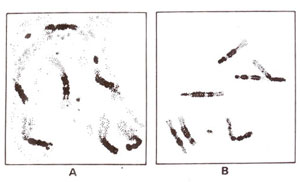Euchromatin and heterochromatin

Fig. 6.11. Chromosomes showing euchromatin and hetero-chromatin. (A) Early prophase (B) Late prophase (redrawn from Stebbins : Chromosomal Evolution in Higher Plants).

Fig. 6.11. Chromosomes showing euchromatin and hetero-chromatin. (A) Early prophase (B) Late prophase (redrawn from Stebbins : Chromosomal Evolution in Higher Plants).
Chromocentres are heterochromatic regions of varying size which occur near the centromeres in proximal regions of chromosome arms. At mid-prophase, many chromocentres can be resolved into strings of chromomeres, which are larger than chromomeres found in distal regions. In some dipteran salivary glands, the chromocentres of different chromosomes fuse to form a large chromocentre. The relative distribution of chromocentres are sometimes considered to be of considerable evolutionary value.Knobs are spherical heterochromatin bodies which may have a diameter equal to the chromosome width but may reach a size having a diameter which is several times the width of the chromosome. Very distinct chromosome knobs can be observed in maize at pachytene stage. Knobs are valuable chromosome markers for distinguishing chromosomes of related species and races.




